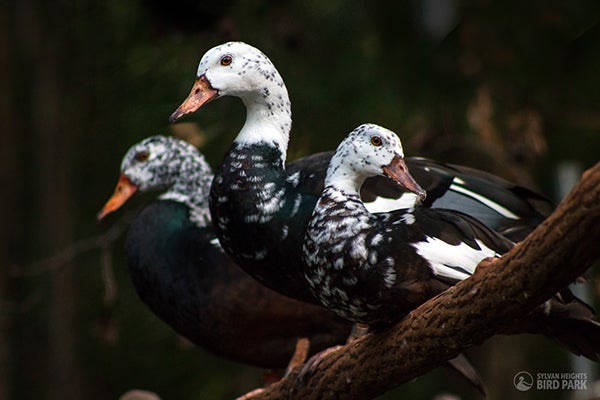ON THE WING
Genome sequencing could help wood duck conservation effort
Through a longstanding partnership between East Carolina University and Sylvan Heights Bird Park in Scotland Neck, researchers have sequenced the genome of the white-winged wood duck, which could help in the conservation effort for the rare avian species.
There are only 150-250 of the birds in captive populations, and probably less than 800 in the wild, said Dustin Foote, general curator of the Sylvan Heights Bird Park. Foote earned his master’s degree in biology at ECU in 2016 and is working on a doctoral degree.

Collaboration between ECU and Sylvan Heights Bird Park has led to genome sequencing of the white-winged wood duck, which could help in conservation efforts. (Contributed photo)
The white-winged wood duck is one of the rarest at the park. Sylvan Heights owns all the white-winged wood ducks in captivity in North America and has birds on loan to 14 other institutions, he said. The species is native to southeast Asia and is notoriously difficult to survey due to its mottled black-and-white coloring and its preferred habitat.
“They really like these flooded forest environments and they just disappear when people are trying to do surveys, and so they’re kind of hard to get a good gauge on … but that’s a tiny number of them,” he said. “In a bad year, they could just be gone.”
Foote’s research on the birds’ genome is aimed at better understanding health issues that affect them, such as avian tuberculosis (TB). The disease is not uncommon in captive bird populations, and white-winged wood ducks are particularly susceptible, he said.
“It really decreases their lifespan … and that’s affecting the long-term sustainability of the captive population, which is going to be a critical component to the future of this species,” Foote said. “So the core of the project is really trying to understand and be able to address why these birds are so susceptible to avian TB.”
Birds from the wild have also been sequenced, and there’s an environmental monitoring component to explore external factors. Because of the small global population, the species has limited genetic diversity, which could play a role, and the team is looking at how the birds are being raised and housed, and how they might be exposed to the disease.
The genomic sequencing is also part of a larger project involving researchers all over the world, which was recently published in Nature.
“This paper is a really big international collaboration of people interested in how genomes evolve, and here the focus is on birds,” said Dr. Chris Balakrishnan, associate professor in the Department of Biology. Balakrishnan’s lab has contributed six sequenced genomes, including Foote’s work on the white-winged wood duck, to the more than 250 genomes analyzed in the project. Former ECU postdoctoral scholar Matthew Louder is also an author on the paper.
“It’s a massive jump in the scale at which we sequence things, and we sequence them to understand where birds came from and what makes birds different from each other, how birds behave, and how to better conserve the bird species that we have,” he said.
The motivation for the sequencing and analysis is ultimately to help the birds, Balakrishnan said. “The big goal … is to figure out this disease problem because it’s limiting their ability to keep these birds and grow the population in captivity.”
Balakrishnan said no effort is needed to figure out why the partnership with Sylvan Heights is a natural one and has been a benefit to researchers. “Sylvan Heights has this dual role in facilitating research … and it’s a zoo so it’s an educational resource” connecting research at the university with conservation and outreach efforts, he said. “It is truly a remarkable facility and so close by.”
Related stories:
What’s the Password?: Parasitic bird species builds link between nature vs. nurture learning systems
